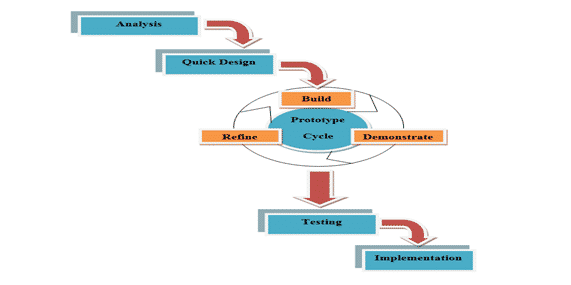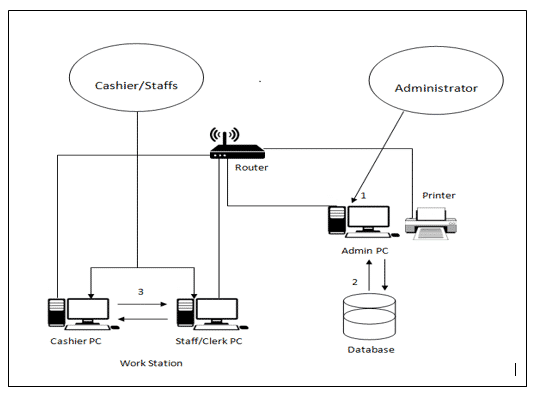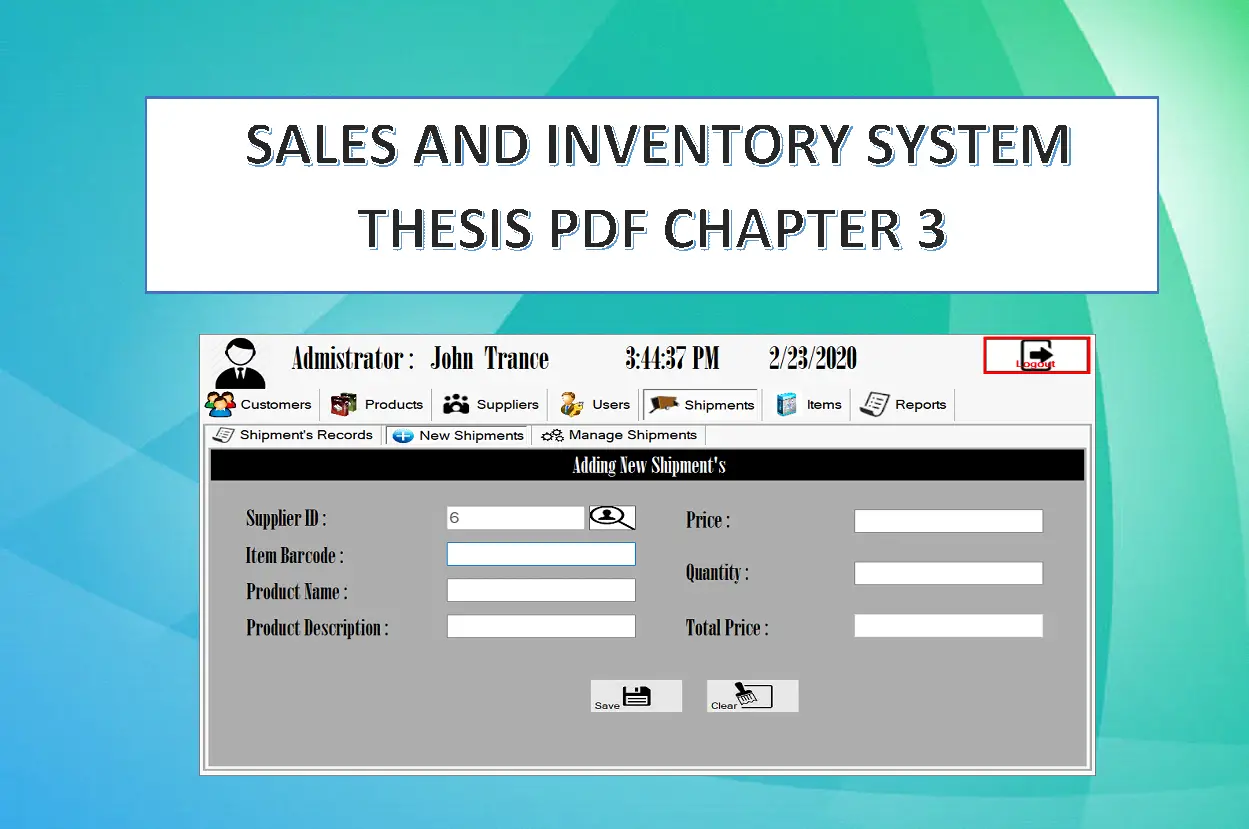Sales and Inventory System Thesis PDF Chapter 3
This article Sales and Inventory System Thesis PDF Chapter 3 discussed on how the problems might be solved by using developing a Sales and Inventory with Decision guide System.
This indicates the contents of the developed machine with the aid of showing the information dictionary which includes all the tables used in the database and the representation of the information float diagram and entity dating diagram.
Here’s the Outline on how to make the Sales and Inventory System Thesis PDF Chapter 3
- Methodology
- Project Development
- Architectural Diagram Interface of Hardware
- System Testing and Implementation
- RV Empire Sale and Inventory System Features
- Recommended Hardware Specification (Server, Workstation)
- Recommended Network and communication device
- Recommended Software Specification (Server/Workstations)
Sales and Inventory System Thesis PDF Chapter 3: Methodology
In this chapter represents about the research methodology and the development of their research design, and then afterward is the development of the prototype system, the discussion about analysis, quick design, and the processes on the prototype cycle that takes place, and lastly the testing and the implementation of the prototype system.
Sales and Inventory System Thesis PDF Chapter 3: Project Development
Software Development Life Cycle or SDLC is a process in which best describes the development, maintaining, changing or enhancing software.
This is where ideas and plans were being constructed in order to develop or to produce software that will provide or will exceed the expectation of the client and will reach the completion within specific time.
SDLC also defines the task that were being performed in software development process step by step as well as maintaining the software.
RAD (Rapid Application Development)

Figure 1: Rapid Application Development diagram shows how the research and process is being develop from the start of the process until it was been finished, Rapid Application Development is easy to use as a methodology model because as you can see from the diagram it was been processed step by step so that the problems that might encountered can be polished or be refined.
In RAD model the function are developed as the prototype is being integrated to make the complete process faster for product delivery, it makes it easier to incorporate the changes within the development process and can quickly give the customer something to see and use to provide feedback regarding the delivery and their requirements.
The advantage of RAD model from the other methodologies is that it reduced the development time, it encouraged the customer to give feedback to the prototype system, and the integration that was been done from the beginning solved a lot of integration issues.
Analysis
In analysis, the researchers conduct the following processes:
- Conduct Interview
In our analysis the proponents first conducted an interview to the company of RV Empire. We ask them information about their Company, their staffs, the owner, but foremost are all about the system that their company is using on their Sales and Inventory, the RV Empire used manual system that gave them the burden on computing their sales reports, it also gives them hard time in securing their stocks and monitoring if there is an overstocking.
Planning
After conducting an interview, the researchers then plan on how they will make a system that will lessen the problem of the said company. The researchers then gathered some of the information that the other company uses in order to make an ease of access, can obtain accuracy, and lessen the time consuming during some process to their company.
Quick Design
The system design should be a user- friendly so that the user can obtain the ease of access so that the processes will be fluently followed. But before that we just created sample designs, with that we could checked wither if it’s correct or should be revised so that the system will meet the expectation that the client wants or will provide the processes that the company’s system required.
Prototype
Prototype is somewhere that has the typical qualities of a particular system that will base or an example that will be used as model that what comes later should be developed. In the prototyping process we have the following processes also:
- Build
In order to create a prototype model for the system we first create forms and also we provide the gathered data’s about the company. In line with this process, we also try to code so that we can run and test if there is some instances that will be polished or errors that might be encountered, after building the prototype model the demonstration of the prototype model follows.
- Demonstrate
After designing the prototype of the system it should be demonstrate to the client on how and what will be the flow of the said system so that they can easily manage and know on how to use it. If there are incorrect process the client can easily notice, or if the client will add some features for the system.
- Refine
If the client wants to add new features to the system or change, refining of the system will follow. In refining process the suggested features or changes of the system will be provided, but first it will be rebuild, then will be demonstrate again and if the client approves the system or they are satisfied, then afterwards it will be tested to the company.
Testing
Testing is where the system be used by the respondents of the project so that they would know if the system is really reliable, efficient and effective in terms of its uses, more advance than on their manual system.
The testing of the proposed system plays an important role because in this process the company will see if the system is totally effective and can make the work of the respondents easier and faster.
Implementation
After the testing of the proposed system, implementation of the system follows, during this phase the new or the created system will be installed in the production process, the users will be trained or will be guided on how the system works.
The system will be given to the client and the processes will be evaluated. In this phase the effort are also required to b implemented, resolving the identified problems, and also planning for sustaining the system.
Sales and Inventory System Thesis PDF Chapter 3 : Architectural Diagram Interface of Hardware
Figure 2: Architectural diagram shows the systems process starts with the administrator, the administrator will register the basic information of the cashier and clerk that will operate on the work stations after recording the information will be sent to the database.
After registering, clerk and cashier can now login at the work station which is connected to the administrator’s computer so that all the transactions will be easily reviewed by the administrator.

Sales and Inventory System Thesis PDF Chapter 3 : System Testing and Implementation
In order to prove that the system is really reliable, in terms of producing information that will be given by the system, it should be first tested so that the client or the proponent will see if the system that is being proposed is effective in terms of its purpose and uses so that can make them satisfied.
The proposed system was been tested by the 3rd year BSIT students as client in the school laboratory. We select some of the students to act as a customer and cashier so that we can visualize if the process is correct as well as the storing of data’s during transaction.
The system is only designed to provide the needs of the company and also to make the transaction process easy and accurately.
Sales and Inventory System Thesis PDF Chapter 3 : RV Empire Sale and Inventory System Features
This Sales and Inventory System provides the following feature that is commonly done in their transaction processes as well as the recording of data’s.
- Provide computerized information record of the staff.
- Easy management of staff, inventory and sales transactions.
- Secure storage of accounts, inventory and transaction records.
- Provide computerized sales and inventory report.
Recommended Hardware Specification (Server, Workstation)
For RV Empire Incorporated Sales and Inventory System be develops and run in a perfect function, but first the client must implement the following hardware specifications:
- Processor Type (64-bit)
- Memory (8GB)
- 40 Gigabyte Hard Drive
- 40 Gigabytes Hard Drive (for Backup)
- 1024 by 768 resolution monitor
- Mouse and Keyboard
- Printer (for receipt)
- Monitor
Recommended Network and communication device
- N300 Wireless ADSL2 + 4 Port Wi-Fi Router
- UTP Cat5e
Recommended Software Specification (Server/Workstations)
- Windows Server 2008 Enterprise Edition
- PHP, MySQL, Apache
- A Backup Utility Software
- MySQL database MySQL Utilities
- Crystal Report
- Visual Basic 2008
Download the Full Source Code of this project
Here’s the complete Source code RV Empire Sales and Inventory System

